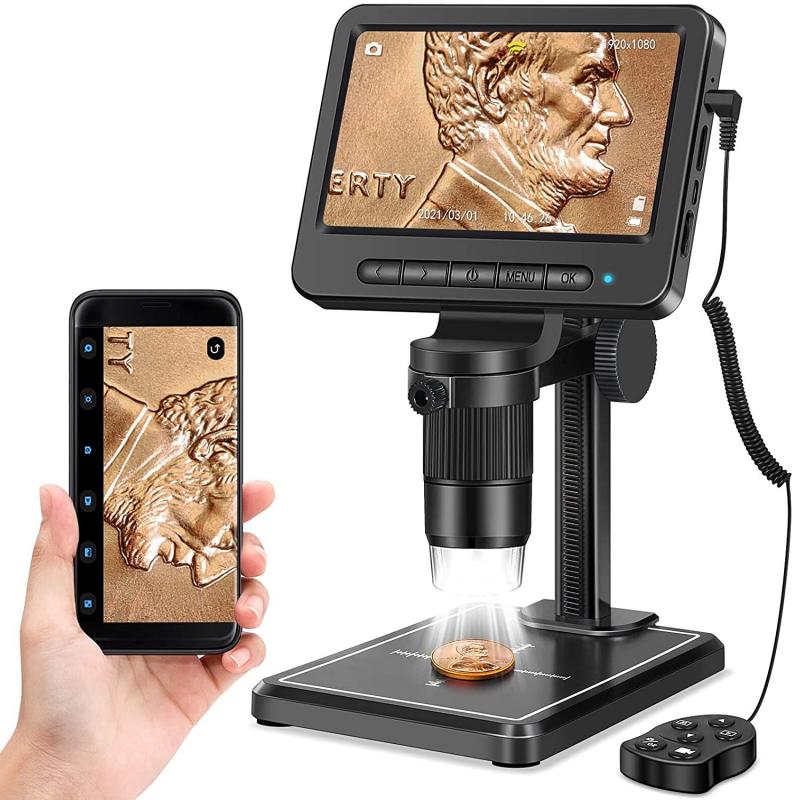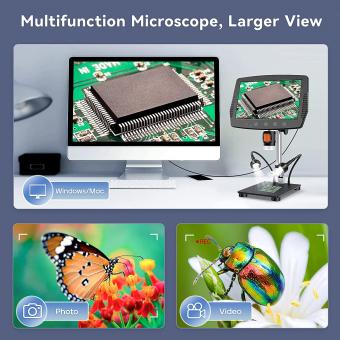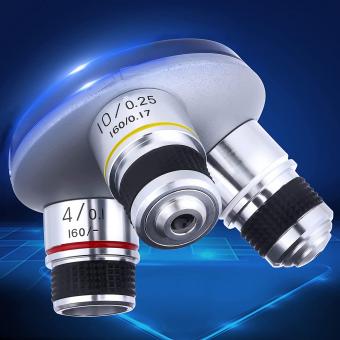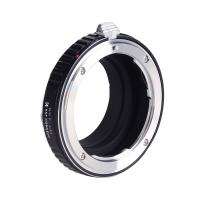What Are The Components Of A Microscope ?
The components of a microscope typically include an eyepiece or ocular lens, an objective lens, a stage, a light source, a condenser, and a focusing mechanism.
1、 Objective lenses
The components of a microscope are essential for its proper functioning and to achieve accurate and detailed observations. One of the key components is the objective lenses. These lenses are responsible for magnifying the specimen and capturing the image. They are usually located on a rotating nosepiece and can be interchanged to provide different levels of magnification.
Objective lenses come in various magnification powers, typically ranging from 4x to 100x or higher. Each lens has a different numerical aperture, which determines its ability to gather light and resolve fine details. Higher magnification lenses have a smaller numerical aperture, allowing for greater resolution but reduced depth of field.
In recent years, advancements in microscope technology have led to the development of new types of objective lenses. One notable example is the introduction of oil immersion lenses. These lenses have a higher numerical aperture and require the use of a special oil between the lens and the specimen to maximize light collection and resolution. Oil immersion lenses are particularly useful for high-resolution imaging, such as in medical research or biological studies.
Another recent development is the use of specialized objective lenses for specific applications. For instance, there are objective lenses designed for fluorescence microscopy, which allow researchers to visualize specific molecules or structures within a specimen. These lenses are equipped with filters and coatings to enhance the detection of fluorescent signals.
In conclusion, objective lenses are a crucial component of a microscope, enabling scientists and researchers to observe and study specimens at various magnifications. With advancements in technology, new types of objective lenses have been introduced, offering higher resolution and specialized capabilities for specific applications.

2、 Eyepiece or ocular lens
The components of a microscope are essential for its functionality and the ability to observe objects at a microscopic level. One of the main components is the eyepiece or ocular lens. This is the lens through which the observer looks to view the magnified image of the specimen. The eyepiece typically contains a magnification factor, such as 10x or 20x, which further enhances the image.
In addition to the eyepiece, a microscope consists of several other components. The objective lenses are crucial as they provide the primary magnification of the specimen. These lenses are usually mounted on a rotating nosepiece, allowing the user to switch between different magnifications. Modern microscopes often have multiple objective lenses with varying magnification powers, such as 4x, 10x, 40x, and 100x.
Another important component is the stage, which holds the specimen being observed. The stage is typically equipped with mechanical controls that allow for precise movement of the specimen in both the x and y directions. This enables the user to navigate and focus on specific areas of interest.
Furthermore, a light source is necessary to illuminate the specimen. In most microscopes, this is achieved using a built-in lamp located beneath the stage. The light passes through the specimen, enhancing visibility and contrast. Some advanced microscopes also incorporate techniques like fluorescence or polarized light to provide additional information about the specimen.
Lastly, microscopes often include additional features such as condensers, diaphragms, and focus knobs. These components help control the amount of light entering the microscope, adjust the focus, and optimize the image quality.
It is worth mentioning that with advancements in technology, digital microscopes have become increasingly popular. These microscopes incorporate a camera and a display screen, allowing users to view the magnified image directly on a monitor. This eliminates the need for an eyepiece and provides the ability to capture and store images for further analysis.
In conclusion, the components of a microscope, including the eyepiece, objective lenses, stage, light source, and additional features, work together to enable the observation of objects at a microscopic level. The latest advancements in technology have also introduced digital microscopes, enhancing the user experience and providing new capabilities in microscopy.

3、 Stage
The components of a microscope include the stage, which is an essential part of the microscope that holds the specimen being observed. The stage is typically a flat platform that can be moved vertically or horizontally to position the specimen under the objective lens. It often has clips or clamps to secure the specimen in place.
The stage is an important component as it allows for precise positioning and manipulation of the specimen, ensuring that it is in focus and centered for observation. It also enables the user to move the specimen around to examine different areas of interest.
In recent years, there have been advancements in microscope technology that have led to the development of motorized stages. These motorized stages can be controlled electronically, allowing for automated movement and precise positioning of the specimen. This feature has greatly improved the efficiency and accuracy of microscopic observations, especially in fields such as pathology and research.
Additionally, some modern microscopes also come equipped with a stage heater or incubator, which allows for the control of temperature and humidity during live cell imaging. This feature is particularly useful in studying biological processes that are sensitive to environmental conditions.
In conclusion, the stage is a fundamental component of a microscope that holds and positions the specimen for observation. With advancements in technology, motorized stages and stage heaters have been introduced, enhancing the precision and capabilities of modern microscopes.

4、 Condenser
The components of a microscope include the condenser, which is an essential part of the optical system. The condenser is responsible for focusing and directing light onto the specimen being observed. It is located beneath the stage and consists of lenses that gather and concentrate light from the light source, typically a bulb or a mirror.
The condenser plays a crucial role in determining the quality and clarity of the image produced by the microscope. By adjusting the position of the condenser, the amount and angle of light can be controlled, allowing for optimal illumination of the specimen. This is particularly important when observing transparent or translucent samples, as proper illumination enhances contrast and visibility.
In recent years, there have been advancements in condenser technology. One notable development is the introduction of adjustable aperture diaphragms in condensers. These diaphragms allow for precise control of the amount of light passing through the condenser, resulting in improved image quality and reduced glare. Additionally, some modern microscopes feature condensers with built-in filters that can selectively block certain wavelengths of light, enabling researchers to enhance specific features or structures in the specimen.
Furthermore, advancements in LED lighting technology have also impacted condenser design. LED light sources are now commonly used in microscopes due to their energy efficiency and long lifespan. The condensers in these microscopes are often optimized for LED illumination, ensuring efficient light transmission and uniform illumination across the field of view.
In conclusion, the condenser is a vital component of a microscope, responsible for focusing and directing light onto the specimen. Recent advancements in condenser technology, such as adjustable aperture diaphragms and LED optimization, have further improved the performance and versatility of microscopes. These developments have contributed to enhanced image quality and improved observation capabilities in various scientific and research fields.







































